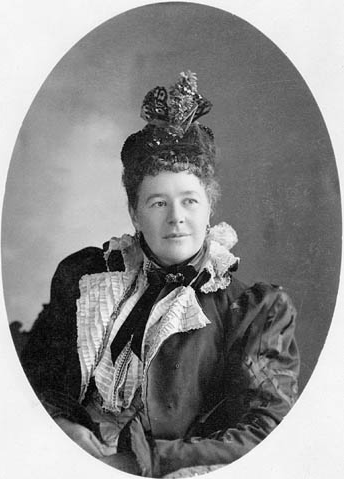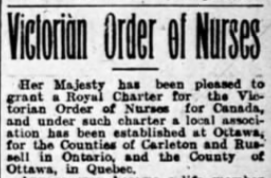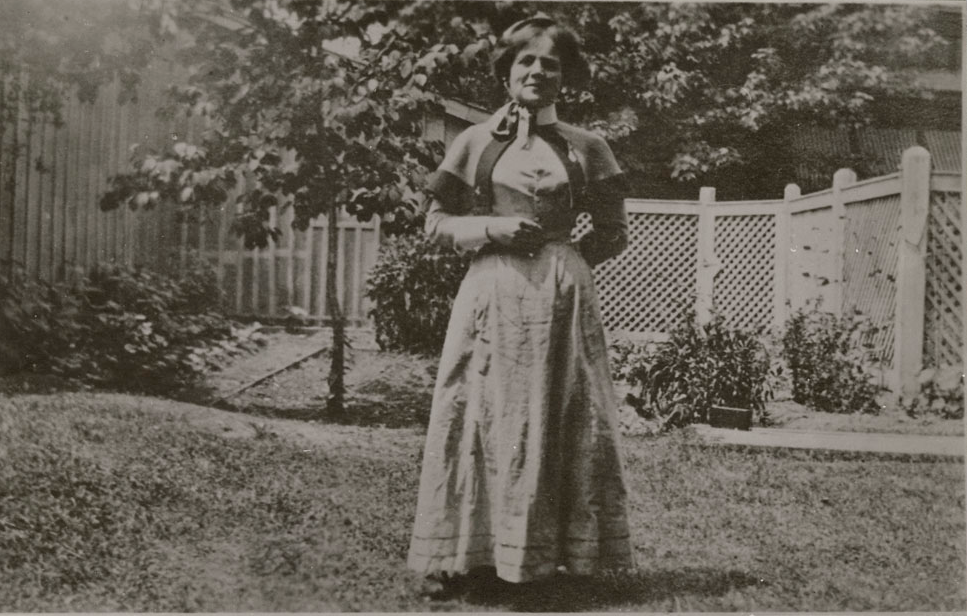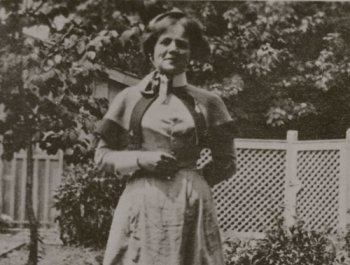10 February 1897
By early 1897 Queen Victoria’s Diamond Jubilee was fast approaching. Across Canada, communities and governments were trying to decide on how best to mark this historic event. On 10 February 1897, a public meeting was held under the auspices of the National Council of Women of Canada in the assembly hall of the Normal School on Elgin Street to discuss a proposal to establish the Victorian Order of Home Helpers as a means of honouring the Queen’s long reign. This idea was consistent with the Queen’s wish that celebrations be connected with efforts to alleviate the suffering of the sick and poor. The Council’s president was the Countess of Aberdeen, the wife of the Governor General. Lady Aberdeen, born Ishbel Marie Marjoribanks, was a woman of extraordinary energy and ability. An early feminist, she had founded a number of charitable organizations in her native Scotland that focused on poor women. Following her husband’s appointment as Canada’s Governor General, she founded in 1894 the National Council of Women of Canada, and was the Council’s first president.
 Lady Aberdeen, 1898, Library and Archives CanadaThe idea of a national organization of “Home Helpers” originated in western Canada, possibly at a meeting of the Vancouver local council of women and Lady Aberdeen. Another report suggested that the idea came from the local council of Victoria, and was later forwarded to the National Council of Women. Regardless, Lady Aberdeen was an early supporter and quickly became identified with the proposal.
Lady Aberdeen, 1898, Library and Archives CanadaThe idea of a national organization of “Home Helpers” originated in western Canada, possibly at a meeting of the Vancouver local council of women and Lady Aberdeen. Another report suggested that the idea came from the local council of Victoria, and was later forwarded to the National Council of Women. Regardless, Lady Aberdeen was an early supporter and quickly became identified with the proposal.
The public meeting at the Normal School was well attended. With the Governor General and senior government officials present, including the Premier, Wilfrid Laurier, Lady Aberdeen addressed the assembly. She stressed the debt owed by women to Queen Victoria—“no section of Her Majesty’s subjects have more cause to sing the praises of this glorious epoch than the members of Her Majesty’s own sex.” She noted that new possibilities had opened up for women during the Queen’s reign. The Queen has demonstrated that a woman can “have an intimate knowledge and grasp of the affairs of state whilst at the same time being a model of all womanly, wifely, and motherly virtues and charms.”
Speaking about the proposed scheme, Lady Aberdeen said Home Helpers would need to have a practical knowledge of midwifery, first aid, home-keeping, simple home sanitation, and the preparation of food for invalids. She thought that a “Home Helper” would be “constantly visiting homes in need—would be giving advice, cheering the home and doing various acts of mercy and kindness.” Successful applicants, who would have to pass an examination set by the medical profession, would be supplied with a uniform and the badge of the Order.
She estimated that $1 million was needed to ensure that funds would be available in perpetuity. Local women’s councils would undertake collections in co-operation with others. The Bank of Montreal agreed to receive subscriptions.
At the public meeting, Wilfrid Laurier, moved the following resolution, seconded by Clifford Sifton, the Minister of the Interior:
That this meeting heartily approves of the general character of the scheme described as the Victorian Order of Home Helpers as a mode of commemoration by the Dominion of the Queen’s Diamond Jubilee, and that a fund be opened for the carrying out thereof.
Despite governmental support, Lady’s Aberdeen’s Order of Home Helpers met mixed reviews, especially from members of the medical profession. Although doctors in Montreal, including Professor Craik, the dean of McGill’s medical school, supported the plan, it was rejected by others, including the Ontario Medical Association, as being impractical and even dangerous. Many feared that well-meaning but otherwise under-qualified women would be sent out to administer to the sick.
In part as a way to alleviate these concerns, the name of the scheme was quickly changed to the Victorian Order of Nurses (VON). The plan was also tweaked to make it clear that only highly-qualified nurses would qualify for the Order. The VON’s objectives were also clarified. They were: i) to provide skilled nurses in sparsely settled regions of the country; ii) to provide skilled nurses to attend sick poor people in their own homes; iii) to provide skilled nurses to attend cases in cities at fixed charges for persons of small incomes; iv) to provide cottage hospitals or small lying-in rooms in homes; and v) to train nurses to carry out these objectives. Nurse salaries, estimated at $400-500 per year, would be paid by the Order, with any fees collected by nurses from those who could afford them to be sent to the Order.
Despite these changes, opposition continued. Many doctors believed that it would be better if physicians and surgeons were paid bonuses to go out to frontier districts, or if funds were used to expand existing hospitals. Others doubted whether “even a very strong-minded female,” would be physically up to the rigours of a north-western winter if called out in the middle of the night.
Lady Aberdeen and other officials worked hard speaking to groups across the country to drum up support for the Victorian Order of Nurses and to dispel rumours that only minimally trained nurses would be hired. They also stressed that instead of replacing doctors, the nurses would, to the extent possible, be working under their direct supervision. This helped. In Winnipeg, the Manitoba Morning Free Press, which had been a fervent opponent to the scheme, was converted. Instead of believing that the Victorian Order of Nurses was “a well-meaning fad” that was “ill-digested, unwise and impractical,” as it had earlier opined, it concluded that “as the scheme becomes better known and its aim better understood, opposition and indifference will disappear.” The paper chided Winnipeg doctors for not attending a public meeting where details of the scheme were presented.
Some criticisms became very personal. The Halifax Herald attacked Lady Aberdeen. It wrote that the proper commemoration of Queen Victoria’s Jubilee was being “frustrated through Lady Aberdeen’s inability to mind her own business.” It was a “thoroughly quixotic scheme” and that “we expect our Governors-General to so govern their own families as to keep them out of mischief.” The New York Evening Post said that Lady Aberdeen was not popular in Canada, being “too clever and too advanced for Canadians.” Instead of paying attention to “etiquette and raiment,” she was “too much interested in ‘movements.’” Clearly the sight of an independent woman striving to make a difference in a male-dominated world was too much to stomach for some members of the public.
Given such criticisms, Lady Aberdeen must have received a much welcomed confidence boost when the British Medical Association and Lord Lister, the father of antisepsis, endorsed the Victorian Order of Nurses. She must have been similarly gratified when Florence Nightingale, the most famous nurse of all time, also came out in favour of her scheme.
 Newspaper clipping announcing the granting of a Royal Charter to the Victorian Order of Nurses, The Ottawa Evening Journal, 3 June 1898.Here in Ottawa, weekly meetings were held through the spring of 1897 in the Governor General’s office in the Departmental building on Parliament Hill to get the VON up and running. A provisional management committee was established, comprised of some high-powered people, including Lady Ritchie, the wife of Canada’s Chief Justice of the Supreme Court, the Bishop of Ottawa, and Sir Henri Joly de Lotbinière, a former premier of Quebec, later to become the Lieutenant Governor of British Columbia. Four trustees were also appointed to manage the money that began to flow to the Order. Sandford Fleming, a resident of Ottawa and the father of world-wide standard time, was one of the trustees. In late April 1897, the VON was officially endorsed by Ottawa citizens at another public meeting at the Normal School. The indefatigable Lady Aberdeen presided.
Newspaper clipping announcing the granting of a Royal Charter to the Victorian Order of Nurses, The Ottawa Evening Journal, 3 June 1898.Here in Ottawa, weekly meetings were held through the spring of 1897 in the Governor General’s office in the Departmental building on Parliament Hill to get the VON up and running. A provisional management committee was established, comprised of some high-powered people, including Lady Ritchie, the wife of Canada’s Chief Justice of the Supreme Court, the Bishop of Ottawa, and Sir Henri Joly de Lotbinière, a former premier of Quebec, later to become the Lieutenant Governor of British Columbia. Four trustees were also appointed to manage the money that began to flow to the Order. Sandford Fleming, a resident of Ottawa and the father of world-wide standard time, was one of the trustees. In late April 1897, the VON was officially endorsed by Ottawa citizens at another public meeting at the Normal School. The indefatigable Lady Aberdeen presided.
Slowly the money began to roll in. Subscriptions began at 5 cents. Both the great and small contributed. Sir Donald Smith (later Lord Strathcona and Mount Royal), the president of the Bank of Montreal and the man who hammered in the last spike on the Canadian Pacific Railway, donated $5,000, and pledged another $5,000 as soon as donations of $100,000 had been made by others contributing $1,000 or more. Meanwhile, fourteen children, the oldest aged 12, at a francophone school near Ottawa sent in their allowances. Their teacher attached a letter to Lady Aberdeen saying “The children of my school cannot pass this occasion to do something for Queen Victoria. Not being rich but having the will to aid the poor, they send you the amount enclosed.” The letter listed the names and ages of the children.
Although the scheme came nowhere near reaching the goal of $1 million, a huge sum back in those days, it received enough in donations and pledges, about $250,000, for it to proceed. On Jubilee Day, 22 June 1897, Lord Aberdeen, the Governor General officially announced the formation of the Victorian Order of Nurses as a lasting tribute to Queen Victoria.
 Miss Charlotte MacLeod, First Chief Superintendent of the Victorian Order of Nurses, 1898, Library and Archives Canada.
Miss Charlotte MacLeod, First Chief Superintendent of the Victorian Order of Nurses, 1898, Library and Archives Canada.
The VON hit the ground running. Within its first year, Lady Aberdeen had acquired the home of Alderman Davis of Ottawa at 578 Somerset Street for the Order’s headquarters. VON training homes were also established in Ottawa, Toronto, Montreal and Halifax. Miss Charlotte MacLeod, who had worked with Florence Nightingale, was named as the VON’s Chief Superintendent. In the spring of 1898, four nurses were sent to help administer to the sick in the Yukon. At this time, tens of thousands of people were travelling to the Klondike in the great gold rush. Disease, owing to poor sanitation, was rampant. Lady and Lord Aberdeen bid the nurses au revoir with a dinner at Rideau Hall on the eve of their departure on their month-long journey to Dawson City.
In early June 1898, it was announced that the Victorian Order of Nurses had received a Royal Charter for Canada as well as a local charter for an Ottawa chapter for the counties of Carleton and Russell in Ontario, and the country of Ottawa in Quebec. Life membership in the Ottawa chapter was set at $100, with an annual membership costing $5. Quickly, Ottawa had 18 life members and 40 annual members. A meeting was also held in the committee room of the Ottawa City Hall to elect a board of management. With the now Sir Sanford Fleming in the chair, an all-woman, twelve-person board was elected. Prominent among them were Lady Laurier and Lady Ritchie.
In late 1898, Lord Aberdeen’s tour of duty as Governor General came to an end. But before the vice-regal couple left Ottawa, Lady Aberdeen received a letter from Colonel Evens, the commandant of the Yukon military contingent expressing his and his soldiers’ “sincere appreciation” for the services of the Victorian Order nurses. “The work of the Victorian Order in Dawson is a great one, and the opening of the new hospital was providential. Their presence with the force has been invaluable…I don’t know how we should have fared without them.”
In 2017, one hundred years after its founding, the Victorian Order of Nurses had 5,000 employees and 9,000 volunteers, and provided 75 home care, support and community services in more than 1,200 Canadian communities.
Sources:
Halifax Herald (The), 1897. “A Halifax Opinion,” in The Ottawa Evening Journal, 25 May.
Manitoba Morning Free Press, 1897. “Victorian Nurses,” 23 April.
————————————-. 1897. “The Victorian Fund,” 28 May.
————————————-, 1897. “Victoria Order,” 28 May.
————————————-, 1897. “Order of Nurses,” 28 May.
————————————-, 1897. “Victorian Order Of Nurses,” 31 May.
————————————-, 1897. “The Victorian Order,” 2 June.
————————————, 1897. “The Victorian Order,” 7 June.
————————————, 1897. “The Doctors And The Victorian Order,” 8 June.
The New York Evening Post, 1897. “Victorian Order of Nurses,” in the Vancouver Daily World, 12 August.
Ottawa Evening Journal (The), 1897. “Victorian Home Helpers,” 11 February.
————————————-, 1897. “Some Explanations,” 3 March.
————————————-, 1897. “Getting Organized,” 19 March.
————————————-, 1897. “Citizens Will Meet,” 21 April.
————————————-, 1897. “Victorian Nurses,” 24 April.
————————————-, 1897. “Ottawa Is In Line,” 26 April.
————————————-, 1897. “Victorian Order of Nurses,” 14 June.
————————————-, 1897. “The Scheme Unpopular,” 13 July
————————————-, 1897. “Eager To Help, 20 July.
————————————-, 1898. “Klondike Nurses,” 28 March.
————————————-, 1898. “Music For Rideau Hall,” 31 May.
————————————-, 1898. “Victorian Order of Nurses,” 3 June.
————————————-, 1898. “Home For V.O.N.” 7 June.
————————————-, 1898. “Women’s Council,” 12 July.
————————————. 1898. “Victorian Nurses In The Klondike,” 1 October.
Vancouver Daily World, 1897. “Women Helpers,” 22 February.
—————————–, 1897. “Taking Practical Form,” 26 March.
—————————–, 1897. “Cablegram from Sir Donald Smith” 28 June 1897.
—————————–, 1897. “Victorian Order Of Nurses,” 1 October.
—————————–, 1898. “Training Home For Nurses,” 27 July.
VON Canada, 2017. http://www.von.ca/.
Story written by James Powell, the author of the blog Today in Ottawa's History.
Retired from the Bank of Canada, James is the author or co-author of three books dealing with some aspect of Canadian history. These comprise: A History of the Canadian Dollar, 2005, Bank of Canada, The Bank of Canada of James Elliott Coyne: Challenges, Confrontation and Change,” 2009, Queen’s University Press, and with Jill Moxley, Faking It! A History of Counterfeiting in Canada, 2013, General Store Publishing House, Renfrew, Ontario. James is a Director of The Historical Society of Ottawa.






